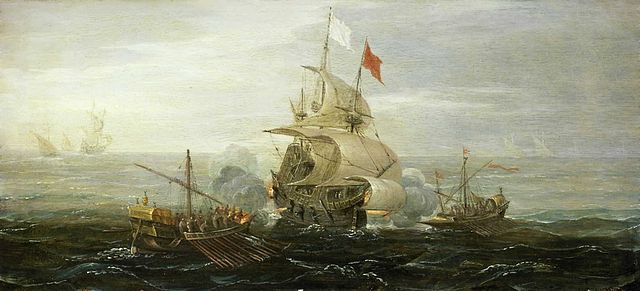The Coasts of High Barbary is a sea shanty and a traditional ballad (Child ballad # 285). The original version, probably, is from the early seventeenth century, it tells of two British merchant ships The George Aloe and The Sweepstake attacked by a French ship, one sank (The Sweepstake) but the George Aloe chases the pirates and defeats them .
Coasts of High Barbary (High Barbary/Barbaree) è una sea shanty e una ballata tradizionale (Child ballad #285). La versione originaria, con buona probabilità, è dei primi del seicento: si racconta di due navi mercantili inglesi The George Aloe e The Sweepstake attaccate da una nave francese, una è affondata (The Sweepstake) ma la George Aloe insegue i pirati e li sconfigge.
The Coasts of High Barbary: “Look ahead, look-astern“
The sea ballad The Coasts of High Barbary resumed popularity in the years between 1795 and 1815 in conjunction with the attacks of Barbary pirates to American ships.
A ship (presumed to be of American nationality) is boarded by a ship of Barbary pirates and after a furious battle she manages to sink it.
La sea ballad The Coasts of High Barbary è la variante americana della storia, che riprende popolarità negli anni tra il 1795 e il 1815 in concomitanza degli attacchi dei corsari barbareschi alle navi americane.
Una nave (presumiamo di nazionalità americana) viene abbordata da una nave di pirati barbareschi e dopo una furiosa battaglia riesce ad affondarla.
“Look ahead, look-astern Look the weather in the lee!”
Blow high! Blow low! And so sailed we.
“I see a wreck to windward, and a lofty ship to lee!
A-sailing down along the coast of High Barbary”
“O, are you a pirate or a man o’ war?” cried we.
“O no! I’m not a pirate but a man-o-war,” cried he.
“Then back up our topsails and heave your vessel to. (1)
For we have got some letters to be carried home by you”.
“We’ll back up our topsails and heave our vessel to.
But only in some harbor and along the side of you”
For broadside, for broadside they fought all on the main;
Until at last the frigate shot the pirate’s mast away.
“For quarter, for quarter”, the saucy pirates cried/But the quarter that we showed them, was to sink them in the tide
With cutlass (2) and gun, we fought for hours three;
The ship it was their coffin and their grave it was the sea
But O! ‘Twas a cruel sight, and grieved us, full sore,
To see them all a drownin’ as they tried to swim to shore
NOTEs
1) Pirates use deception for boarding
2) the cutlass is the typical sword of the sailors. With a short and wide blade slightly curved. Cutlass is a term in use in the Renaissance probably derived from the Italian coltellaccio. It is the weapon preferred by pirates because it is robust and suitable for close combat.
“Guarda il tempo a prua, guarda a poppa e a sottovento!”
(tira in su, tira in giù! E così siamo salpati)
“Vedo un relitto a sopravvento e una nave maestosa sottovento che naviga lungo la costa di Barberia.”
“Siete un pirata o un militare?”
“Non sono un pirata ma un militare” – disse lui
“Allora ammainate le vele e mettetevi in panna
perchè abbiamo delle lettere da farvi portare a casa (1)”
“Ammaineremo le vele e ci metteremmo in panna
ma solo in un porto e accanto al vostro fianco”
A bordate, a bordate si combatterono sul mare
finchè alla fine la fregata colpì l’albero maestro dei pirati
“Mercede, mercede” – gridarono quei pirati impudenti-
ma la grazia che gli mostrammo fu di affondarli in mare.
Con sciabola (2) e pistola ci siamo battuti per tre ore
e la nave divenne la loro bara e il mare la loro tomba.
Fu uno spettacolo crudele che ci addolorò tanto
vederli annegare mentre cercavano di nuotare a riva.
NOTE traduzione italiana Cattia Salto
(1) I pirati usano l’inganno per l’abbordaggio
(2) il cutlass è la tipica spada dei marinai detta in italiano “sciabola d’abbordaggio”. Dalla lama corta e larga leggermente ricurva. Cutlass è un termine in uso nel rinascimento probabilmente derivato dall’italiano coltellaccio. E’ l’arma preferita dai pirati perchè robusta e adatta ai combattimenti ravvicinati.

